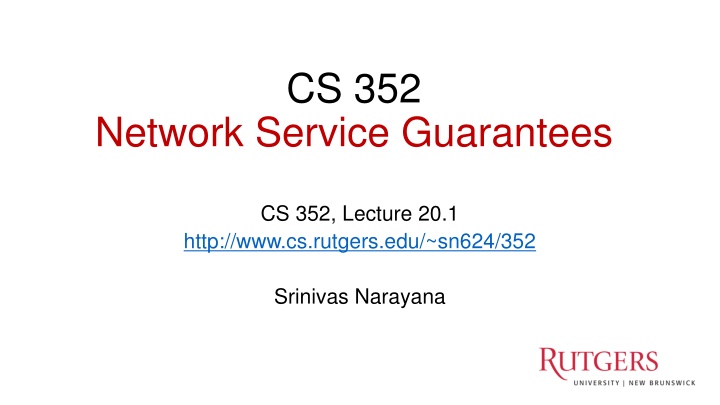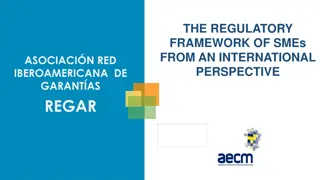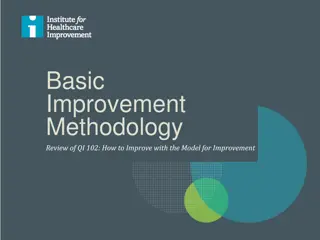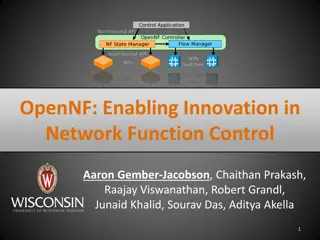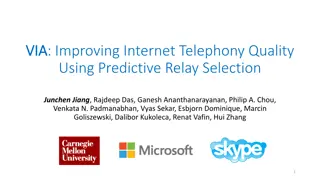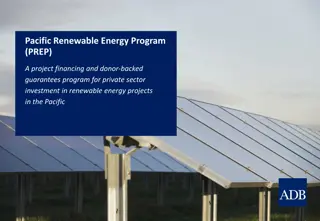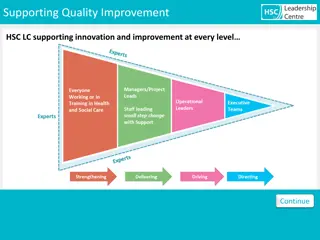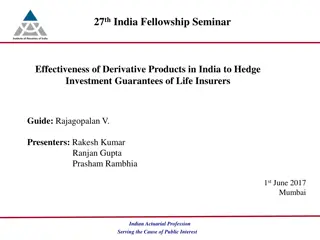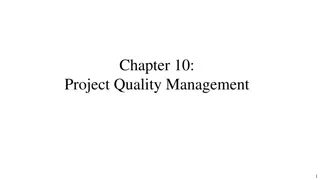Network Service Guarantees and Quality Improvement
Network service guarantees play a crucial role in ensuring the quality of service for applications. Best-effort internet architecture lacks guarantees on delay, bandwidth, and loss, leading to challenges for applications requiring special treatment. To address this, approaches like provisioning more capacity and implementing classes of service can enhance network performance and cater to diverse application needs. By improving beyond best-effort, networks can support various applications effectively.
Download Presentation

Please find below an Image/Link to download the presentation.
The content on the website is provided AS IS for your information and personal use only. It may not be sold, licensed, or shared on other websites without obtaining consent from the author.If you encounter any issues during the download, it is possible that the publisher has removed the file from their server.
You are allowed to download the files provided on this website for personal or commercial use, subject to the condition that they are used lawfully. All files are the property of their respective owners.
The content on the website is provided AS IS for your information and personal use only. It may not be sold, licensed, or shared on other websites without obtaining consent from the author.
E N D
Presentation Transcript
CS 352 Network Service Guarantees CS 352, Lecture 20.1 http://www.cs.rutgers.edu/~sn624/352 Srinivas Narayana 1
Network Application FTP HTTP HTTPS SMTP DNS Transport UDP TCP IP Network X.25 802.11 ATM Host-to-Net The network layer moves packets from one place to another. The network will put in its best effort but makes no guarantees.
Network support for applications A best effort Internet architecture does not offer any guarantees on delay, bandwidth, and loss Network may drop, reorder, corrupt packets Network may treat traffic randomly regardless of their importance However, many apps require special treatment & guarantees E.g., voice over IP (phone calls) require strict delay guarantees E.g., HD video requires a reasonable minimum bandwidth E.g., remote surgery with 3D-vision requires strict sync & latency Q: How to provide quality of service (QoS) for apps?
Why best effort isnt enough: Contention High delay Conf call: Requires low latency Packet drops BitTorrent: Requires high throughput FIFO queue Resource contention occurs in the core of the network Congestion control will react, but may be too little & too late: Congestion control can t prevent packet drops now Congestion control won t prevent high-sending-rate flows from inflicting large delays or recurring drops
Can networks help improve the quality of service for applications? Yes, but networks must become better than best-effort.
Approach 1: Provision more capacity If you re an ISP (e.g., AT&T), you might deploy enough capacity so that contention doesn t occur any more Low complexity: can use current best effort network However, this approach incurs high costs (e.g., bandwidth) A key challenge: estimating how much bandwidth is enough Need to estimate demand over time Network operators can do this quite well usually But there are exceptional circumstances: pandemics, Superbowl, etc. 6
Approach 2: Classes of service Have the network treat different traffic differently Also called traffic differentiation Analogy: lines at an airport (e.g., first class vs. economy) Partition traffic into classes and offer service guarantees per class and across classes Classes may be indicated using the IP type of service header bits Classes may be inferred from IP & transport headers (e.g., src/dst/ports) Packet classification: assigning packets to classes (Not in scope: we won t discuss packet classification)
(1) Strict prioritization Transmitted immediately regardless of HTTP packets Conf call H3 H1 R1 R2 H4 1.5 Mbps link H2 HTTP Suppose a 1Mbps interactive flow and an HTTP connection share a 1.5 Mbps link. A network operator (e.g., Rutgers admin) might choose to prioritize the interactive app strictly over the HTTP flow.
(2) Rate limiting Rate limited to 1 Mbit/s Conf call H3 H1 R1 R2 H4 1.5 Mbps link H2 HTTP What if a flow doesn t respect its allocation? Example: Say, conf call flow goes beyond 1 Mbit/s Don t want to starve HTTP flow! An operator might want to limit a flow to a certain max rate Isolation: HTTP should not be impacted by the conf call
(3) Weighted fair sharing Allocated 2/3rd of the link Conf call w=2 H3 H1 R1 R2 H4 Allocated 1/3rd of the link H2 HTTP w=1 An operator might want to partition the link s rate C into separate allocations for each class Partitions may have weights w (example: 2, 1) Usually, class i gets the illusion of traversing a logical link of rate wi* C / j wj
(3) Weighted fair sharing Class 1 Customary to think of different classes as belonging to different queues For this reason, weighted fair sharing is also called weighted fair queueing (WFQ) Each queue is first-in-first-out (FIFO) The link multiplexes among these queues Intuitively, packets of one queue should not influence the behavior of other queues Hence, fair queueing is also a form of isolation across traffic classes Class 2 Link Class 3
(3) Weighted fair sharing Class 1 But what if one class doesn t use its share? Can other classes use the spare capacity? Class 2 Yes! WFQ is work-conserving: a router implementing WFQ will allow other classes to use the unused capacity Link Class 3 Work conservation makes WFQ different from rate limits applied separately to each class Class i s usage can exceed wi* C / j wj (only if spare capacity is available, of course.)
Q: Where are guarantees enforced? We ve seen three kinds of service guarantees: prioritization, rate limiting, and fair sharing Common goal: allocate the bottleneck link capacity across packets from traffic classes This allocation occurs in the packet scheduler in the bottleneck router Recall: scheduling is the task of choosing the packet (among buffered packets) which is transmitted over the output link A router is said to implement packet scheduling policies
Why care about service guarantees? Influences how packets are treated at contentious resources in the core of the network Regardless of the endpoint transport Next lecture: a deeper look at mechanisms for one kind of service guarantee Service guarantees: prioritization, rate limiting, fair sharing Implementations of scheduling (QoS) within large networks have implications for debates on network neutrality Scheduling is a fundamental problem in computer networks
CS 352 Rate Limiting CS 352, Lecture 20.2 http://www.cs.rutgers.edu/~sn624/352 Srinivas Narayana 17
Review Packet drops High delay Conf call H3 H1 FIFO queue H4 1.5 Mbps link H2 HTTP Best-effort network isn t enough Applications might require more guarantees 3 mechanisms: prioritization, rate limiting, and fair sharing This module: implementation of rate limiting
Measures of transmission rate Long-term/average rate: data rate transmitted per unit time, over a long period Crucial question: what is the time interval over which rate is measured? Average and instantaneous behaviors can be very different Same average rate Rate Rate Measurement duration Measurement duration Time Time
Measures of transmission rate Peak rate: largest instantaneous rate that is transmitted Measurement duration is typically very small Burst size: maximum amount of data sent consecutively without any intervening idle periods Measurement duration peak rate Rate Time
Rate enforcement There are two kinds of rate enforcement policies: shaping and policing Two specific mechanisms to implement those: leaky buckets and token buckets
Shaping vs. Policing Enforces rate by queueing excess packets in a buffer Drop only if buffer is full Enforces rate by dropping excess packets immediately Can result in high loss rates Requires memory to buffer packets Does not require a memory buffer Can inflate round-trip time (queueing in shaping buffer) No additional inflation in round-trip times
Intuition: release packets at steady rate Packets from source Bucket leaking water at a steady Leaky Bucket Shaper Shaping buffer rate Timed release mechanism for packets Packets leaving at steady rate
Leaky Bucket Shaper Packets may enter in a bursty manner However, once they pass through the leaky bucket, they are evenly spaced The shaping buffer holds packets up to a certain point If the buffer is full, packets are dropped (true of any shaper) Setting the rate is a policy concern Assume an admin provides us the rate Shapers may be used in the core of a network to limit bandwidth use, or at the edge to pace packets entering the network in the first place
Leaky Bucket Shaper For a leaky bucket shaper, assume average rate == peak rate However, many Internet transfers just have a few packets For example, web requests and responses Enforcing rate limit for those can significantly delay completion We often wish to have peak rate higher than avg rate If so, use a token bucket: burst-tolerant version of a leaky bucket
Token bucket shaper Fill at rate r Limits traffic class to a specified average rate r and burst size B Tokens are filled in at rate r The token bucket can hold a maximum of B tokens. Further tokens dropped Note: distinct from shaping buffer size Suppose a packet is at the head of the shaping buffer If a token exists in the bucket, remove token, and transmit the packet If not, wait. Bucket size B Packets Remove token Transmit Shaping buffer
Token bucket shaper Fill at rate r In time t, the maximum number of packets that depart the shaper is (r * t) + B A full bucket of tokens would allow small flows to go through unaffected A maximum burst of B packets Longer flows have average rate r Bucket emptied initially, the rest of the flow must respect the token fill rate As t , the average rate approaches r That is, (1/t) * (r*t + B) r Bucket size B Packets Remove token Transmit Shaping buffer
Token bucket policer Fill at rate r A token bucket policer is just a token bucket shaper without the shaping buffer No place for packets to wait if there are no tokens If token exists, packet transmitted. If not, packet dropped Simple and efficient to implement. The internet has tons of token bucket policers Bucket size B Packets Remove token Transmit Shaping buffer
Google study from 2016 Small but non-trivial fraction of policed links Significant impact on packet loss rate Flach et al., An Internet-Wide Analysis of Traffic Policing, SIGCOMM 2016
Impact on TCP Policers drop multiple packets in a burst: causing RTOs and retransmissions after emptying of token bucket Slow start period: burst allowed with a full bucket of tokens
Effect on actual apps: YouTube Video rebuffer rate: rebuffer time / overall watch time
Summary of rate limiting Rate limiting is a useful mechanism to isolate traffic classes from each other Two strategies: policing and shaping Leaky bucket and token bucket The Internet has a lot of token bucket policers, causing real impact on TCP connections and app performance
